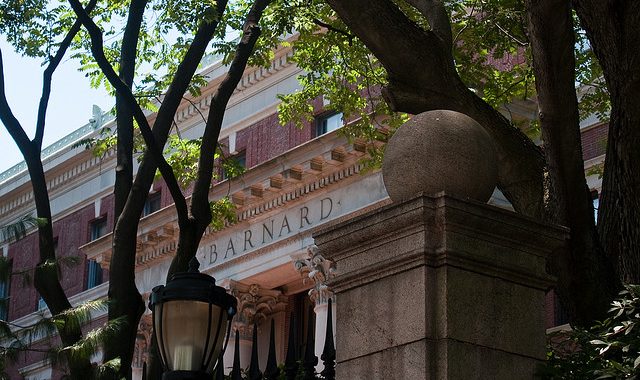Barnard College of Columbia University was the location of the November 15th “SENCER and Teaching with Technology” MidAtlantic Regional Conference. Attendees were treated to sweeping views of Barnard and Columbia from the LEED–certified Diana Center, complete with post-conference reception on the Greenroof, complements of Provost Linda A. Bell. Peter Bower hosted the conference and explained some of the local history of Barnard, including the Revolutionary War battle site on which the campus is located, being the first victory of the Continental Army. Monica Devanas greeted the attendees and presented a special guest, Caroline LaPorte-Burns who brought a warm Welcome Message from her father, David Burns. Ellen Mappen described the SENCER Informal Science Project and introduced Frank Wattenberg, Co-PI of the SENCER Engaging Mathematics Project, who described the work of that collaboration of faculty from six schools across the nation. Eliza Reilly, NCSCE Director of Programs, also welcomed the group on behalf of the national office staff.
Peter Bower (Environmental Science, Barnard) updated all on “Brownfield Action” his 2003 SENCER Model course at Barnard College, which has been reproduced for CUNY students as a “hybrid” online course. With over half a million brownfield sites in the US, Bower’s “Brownfield Action” provides students with complex environmental situations, giving them opportunities for unscripted problem-solving, critical thinking, and leadership development.
A broad spectrum of STEM-based projects were featured at the meeting. Anindita Ghosh (Physics, Suffolk Community College) described her “Better with Buttons” strategies using online simulations to assist student in understanding the critical elements in physics, developing and carrying out a plan for solving problems and reflecting on the feasibility. Eugene Galperin (Mathematics, East Stroudsburg University) explained his use of Pearson’s MyMathLab for structuring online homework, quizzes and homework application assignments. Only after homework and quiz can students move on to “extra credit” assignment using images and story-telling skills to present a personally relevant consumer comparison with recommended choice outcomes. Galperin noted that this strategy was very effective in motivating students to work beyond the minimum expectations, finding that they actually enjoy the applications of math principles to answer meaningful questions. Esther Wilder (Mathematics, Lehman College and Graduate Center, CUNY) and Frank Wang (Mathematics, LaGuardia Community College) described their quantitative reasoning across the curriculum project, “Numeracy Infusion Course for Higher Education,” an NSF funding grant, which supports an online clearing house of teaching materials as well as teacher training in summer courses. Check out http://teachqr.org to connect with this rich reserve of quantitative reasoning learning goals, best practices, assessment tools, teaching resources and links.
STEM educators teach with technology, and some teach technology, as does Herb Schanker (College of Staten Island). Schanker presented an introduction to his 2013 SENCER Model “TechEP – An Emerging Model of Curricular Integration.” This Model presents resources to make technology ubiquitous, engaging and relevant by supporting lectures and labs with comprehensive and evocative resources and reports that explore civic, ethical and political questions embedded or emerging from the technology revolution. The challenges and opportunities afforded by teaching online courses were addressed by a panel of Donatello Delfino (Mathematics, New York University) and Godfrey Roberts (Science Education, New York University). Online environments can effectively reinforce content throughout the week when face-to-face meetings are less frequent. They can also encourage deep and meaningful discussions from multiple perspectives from participants across the globe. Both our presenters shared examples from their practice.
Technology can be a lever to engage students as Frank Wattenberg (Mathematics, US Military Academy) demonstrated with the multiple applications made possible by “Arduino Kits.” These inexpensive motherboards can be used to collect many kinds of environmental variables simple by changing the sensor probes. The effectiveness of this problem-based approach to learning was evident in the project presented by Cadet Ben Minden, who programed the Arduino kits to work with drones. Minden is collaborating with Wattenberg on a senior project to package simple programming components with drone components to provide middle school students with tools to make and fly their own drones.
Presenting vast quantities of molecular cell biology and genetics was the challenge for Katayoun Chamany (Biology, Eugene Lang School). Chamany worked with information designers to create a radial graphic to represent all the stem cells, their origins and development. Seeing the information from multiple vantage points improved cognitive flexibility and critical thinking since much of the brain’s retrieval of information depends on visual literacy. Using this graphic as the basis for content discussion, Chamany has found that this format has been very helpful to students in Law, Journalism and Race and Gender Studies, as well as STEM students. Joseph Liddicoat (Information Science, Barnard College, New York University) discussed other applications of graphics specifically his fully online course version of “Brownfield Action” as well as his “Planets, Stars and Life” online course. Both of these courses engage students in considering a collection of variables in a problem-solving context that generate critical thinking, cognitive and leadership skills as well.
All great applications must prove their effectiveness and Trace Jordan (Mathematics, New York University) reviewed the SENCER Student Assessment of Learning Gains assessment tool. Looking at student self-reporting is a valid indirect assessment and the SENCER-SALG provides context for knowledge, skills and attitudes that many student surveys do not. Jordan explained his own use of the SENCER-SALG for course improvement and research on his teaching.
Following this day of exciting presentations everyone enjoyed continued discussions on the roof with refreshments compliments of Provost Linda A. Bell. It was a great day by all accounts.
Photo credit: Patrick Nelson. No changes were made to the original photo. Link to license.

